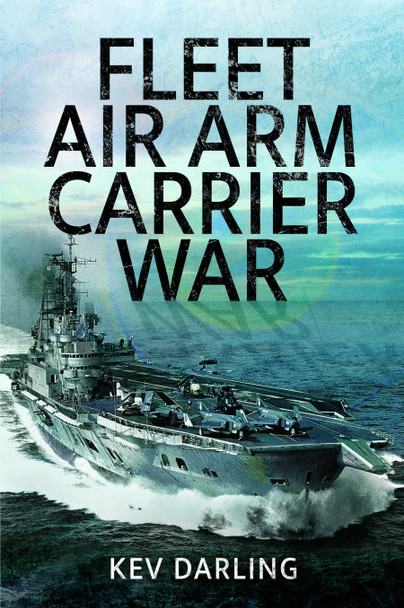
Fleet Air Arm Carrier War. By Kev Darling. Pen & Sword Aviation, Barnsley, 2009, 2022. ISBN: 978 1 39907 500 8
Reviewed by David Hobbs
Kev Darling spent twenty years as an engineer in the RAF before beginning a writing career in 1986. Since then he has written dozens of books and monographs on British and American aviation related topics. This book is a reprint of a title first published in 2009 by Pen & Sword and it appears not to have been updated or modified in any way.
The publisher quotes a 2009 review by Baird Maritime on the back cover which states that there have been ‘remarkably few’ books about British naval aviation in comparison with those written about the USN but that this ‘very well illustrated book puts things right’. Unfortunately this review, taken out of date context, gives a completely misleading impression. There have been dozens of books published about British naval aviation since 2009, many of them published by Pen & Sword and its various imprints. There were actually a substantial number published before 2009 as those interested in reading about naval aviation will know.
I believe that a reviewer should always try to find something positive to say about a book submitted to him, however, and in this instance I found that the photographs have indeed been well chosen and reproduced with excellent clarity. They contribute to the subject’s historiography but that, I am afraid, is it as far as positivity goes because the text makes no such contribution. It is clearly derived from earlier books and perpetuates some of their errors but shows no evidence of research into primary sources. The bibliography lists only four published books.
The text contains a number of mistakes and misconceptions that prevent me from recommending it to anyone with a serious interest in the subject. Whilst I did look at all the photographs I am afraid that I found the errors simply too annoying and before reaching the end I had had enough of them. To give examples the author states on page 11 that Eugene Ely took off from the USS Birmingham on 4 November 1910. The actual date was 14 November. 1910. After describing Ely’s landing on the USS Pennsylvania in 1911 Darling goes on to write that ‘news of the American research had reached the Admiralty in 1909 and their response was to build the rigid airship Mayfly’. Apart from being a gross oversimplification about the origins of Rigid Airship number 1 which actually originated in 1908, he fails to explain what news had reached the Admiralty and stimulated a ‘response’ to events that had yet to take place. On page 12 he describes Commander Schwann as the pilot chosen [by the Admiralty] to undertake seaplane trials in 1912 at Barrow-in-Furness. His experiments actually took place in 1911, before he had even qualified as a pilot, but after he had bought the Avro Type D as a private venture with funds raised by friends and their wives to form the ‘Seaplane Club’ whilst they stood by as rigid airship number 1 was built by Vickers. It was never officially funded by the Admiralty and he even had to take out insurance for one of his senior air mechanics to cover work outside his normal naval duties. He and the other sailors standing by the rigid airship built the floats out of surplus construction materials. Despite Schwann’s lack of qualification, his take-off in the Avro seaplane from Cavendish Dock at Barrow in November 1911 was the first by a British seaplane. The subsequent crash did not write off the aircraft or injure him but could not be considered the first seaplane landing. Schwann was not one of the first course of RN fixed-wing pilots trained at Eastchurch as claimed on page 13 but he did qualify as a pilot later. The misunderstood description of Schwann and his private venture experiments shows a lack of knowledge about the subject matter made worse by a lack of research that would have ensured factual accuracy in the narrative. I could go on listing errors and misunderstandings but I hope by now to have made the point that I found the text of this book to be extremely disappointing. I certainly cannot recommend it.



